Tourism Marketing and Sustainability
VerifiedAdded on 2020/01/15
|8
|2855
|197
AI Summary
This assignment explores various aspects of tourism marketing with a focus on sustainability. It requires students to analyze published research papers on topics such as low-impact tourism, intangible cultural heritage, and the role of relationship marketing in competitive strategies within the tourism industry. Additionally, students need to evaluate online resources related to travel and tourism trends, policies, and industry practices.
Contribute Materials
Your contribution can guide someone’s learning journey. Share your
documents today.
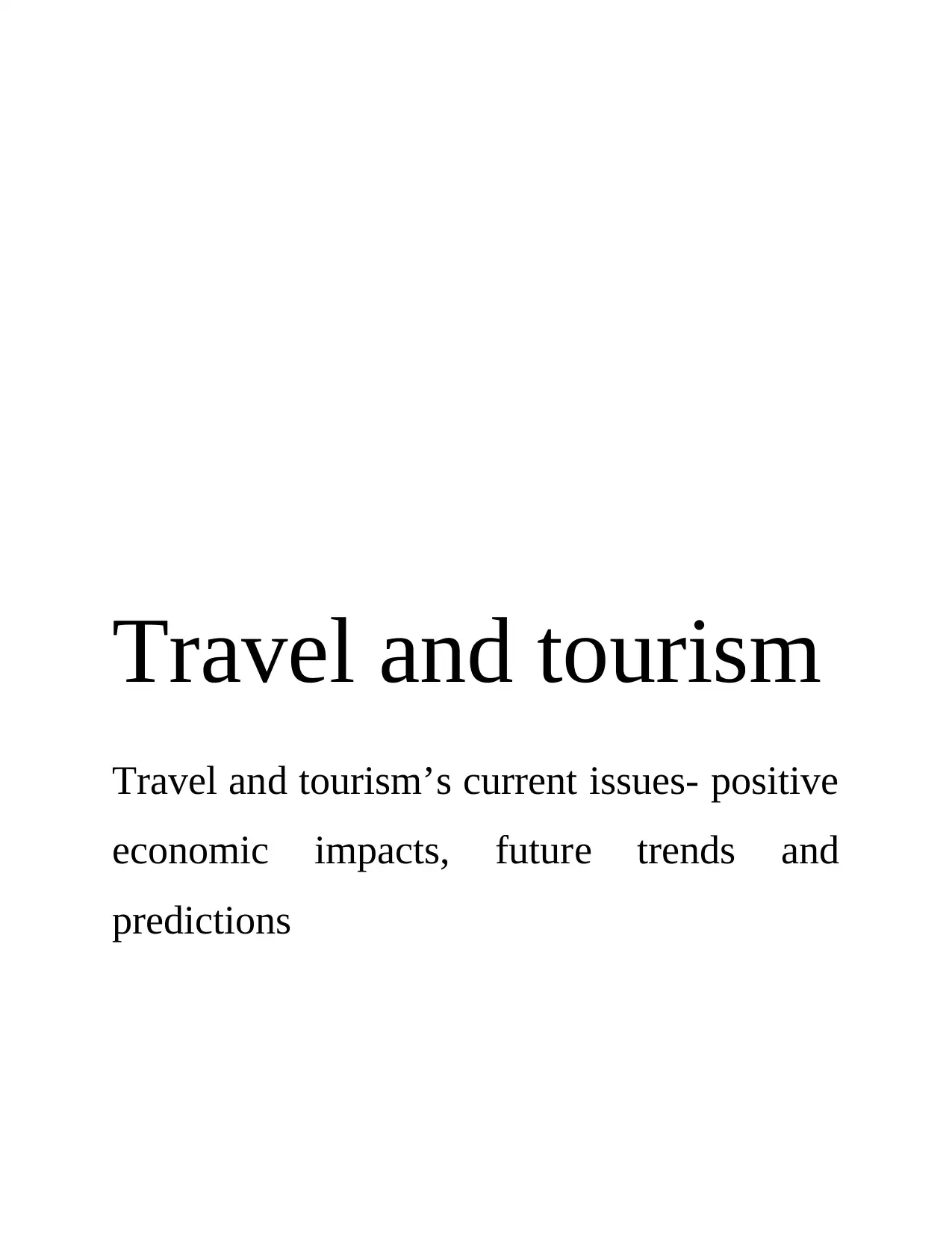
Travel and tourism
Travel and tourism’s current issues- positive
economic impacts, future trends and
predictions
Travel and tourism’s current issues- positive
economic impacts, future trends and
predictions
Secure Best Marks with AI Grader
Need help grading? Try our AI Grader for instant feedback on your assignments.
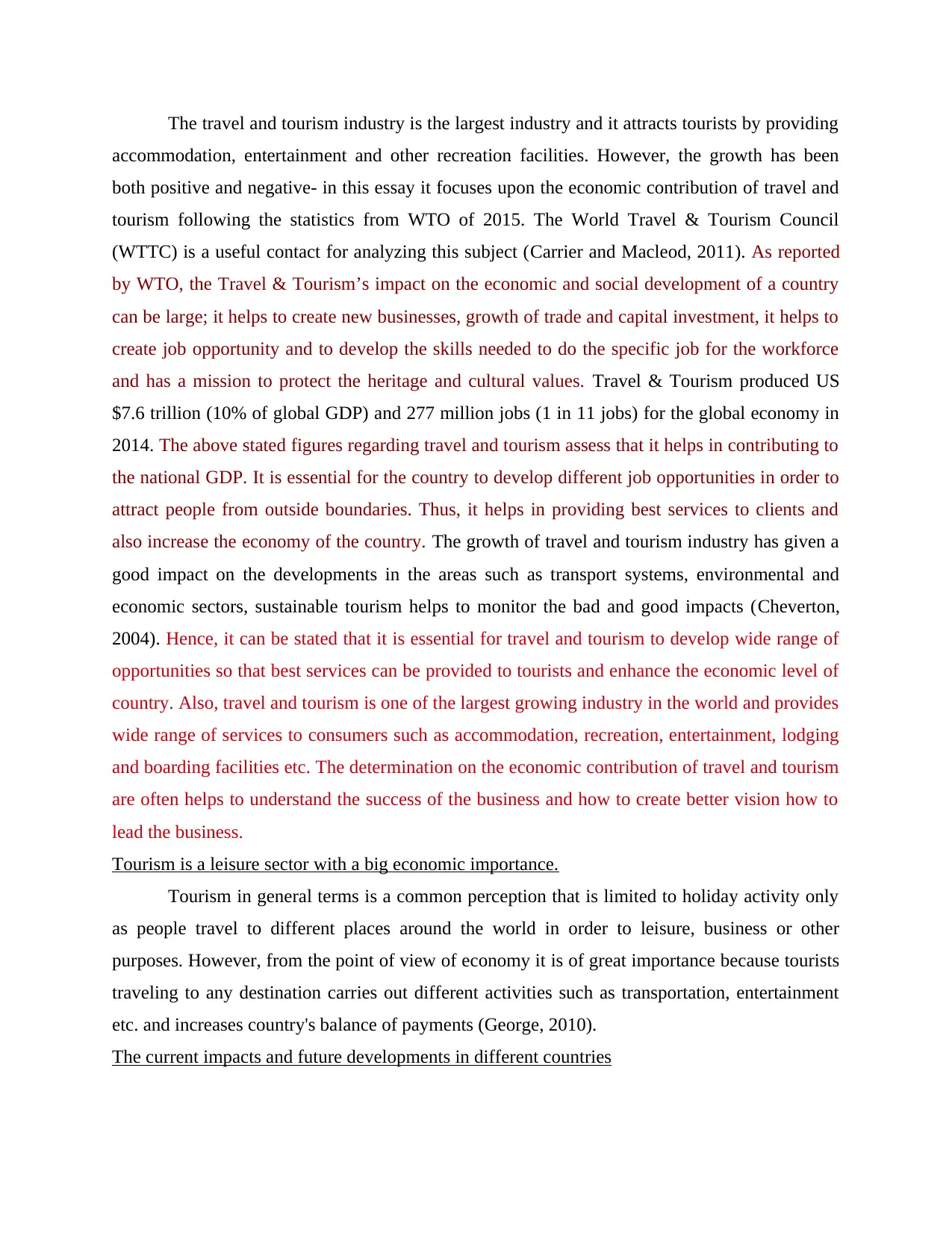
The travel and tourism industry is the largest industry and it attracts tourists by providing
accommodation, entertainment and other recreation facilities. However, the growth has been
both positive and negative- in this essay it focuses upon the economic contribution of travel and
tourism following the statistics from WTO of 2015. The World Travel & Tourism Council
(WTTC) is a useful contact for analyzing this subject (Carrier and Macleod, 2011). As reported
by WTO, the Travel & Tourism’s impact on the economic and social development of a country
can be large; it helps to create new businesses, growth of trade and capital investment, it helps to
create job opportunity and to develop the skills needed to do the specific job for the workforce
and has a mission to protect the heritage and cultural values. Travel & Tourism produced US
$7.6 trillion (10% of global GDP) and 277 million jobs (1 in 11 jobs) for the global economy in
2014. The above stated figures regarding travel and tourism assess that it helps in contributing to
the national GDP. It is essential for the country to develop different job opportunities in order to
attract people from outside boundaries. Thus, it helps in providing best services to clients and
also increase the economy of the country. The growth of travel and tourism industry has given a
good impact on the developments in the areas such as transport systems, environmental and
economic sectors, sustainable tourism helps to monitor the bad and good impacts (Cheverton,
2004). Hence, it can be stated that it is essential for travel and tourism to develop wide range of
opportunities so that best services can be provided to tourists and enhance the economic level of
country. Also, travel and tourism is one of the largest growing industry in the world and provides
wide range of services to consumers such as accommodation, recreation, entertainment, lodging
and boarding facilities etc. The determination on the economic contribution of travel and tourism
are often helps to understand the success of the business and how to create better vision how to
lead the business.
Tourism is a leisure sector with a big economic importance.
Tourism in general terms is a common perception that is limited to holiday activity only
as people travel to different places around the world in order to leisure, business or other
purposes. However, from the point of view of economy it is of great importance because tourists
traveling to any destination carries out different activities such as transportation, entertainment
etc. and increases country's balance of payments (George, 2010).
The current impacts and future developments in different countries
accommodation, entertainment and other recreation facilities. However, the growth has been
both positive and negative- in this essay it focuses upon the economic contribution of travel and
tourism following the statistics from WTO of 2015. The World Travel & Tourism Council
(WTTC) is a useful contact for analyzing this subject (Carrier and Macleod, 2011). As reported
by WTO, the Travel & Tourism’s impact on the economic and social development of a country
can be large; it helps to create new businesses, growth of trade and capital investment, it helps to
create job opportunity and to develop the skills needed to do the specific job for the workforce
and has a mission to protect the heritage and cultural values. Travel & Tourism produced US
$7.6 trillion (10% of global GDP) and 277 million jobs (1 in 11 jobs) for the global economy in
2014. The above stated figures regarding travel and tourism assess that it helps in contributing to
the national GDP. It is essential for the country to develop different job opportunities in order to
attract people from outside boundaries. Thus, it helps in providing best services to clients and
also increase the economy of the country. The growth of travel and tourism industry has given a
good impact on the developments in the areas such as transport systems, environmental and
economic sectors, sustainable tourism helps to monitor the bad and good impacts (Cheverton,
2004). Hence, it can be stated that it is essential for travel and tourism to develop wide range of
opportunities so that best services can be provided to tourists and enhance the economic level of
country. Also, travel and tourism is one of the largest growing industry in the world and provides
wide range of services to consumers such as accommodation, recreation, entertainment, lodging
and boarding facilities etc. The determination on the economic contribution of travel and tourism
are often helps to understand the success of the business and how to create better vision how to
lead the business.
Tourism is a leisure sector with a big economic importance.
Tourism in general terms is a common perception that is limited to holiday activity only
as people travel to different places around the world in order to leisure, business or other
purposes. However, from the point of view of economy it is of great importance because tourists
traveling to any destination carries out different activities such as transportation, entertainment
etc. and increases country's balance of payments (George, 2010).
The current impacts and future developments in different countries
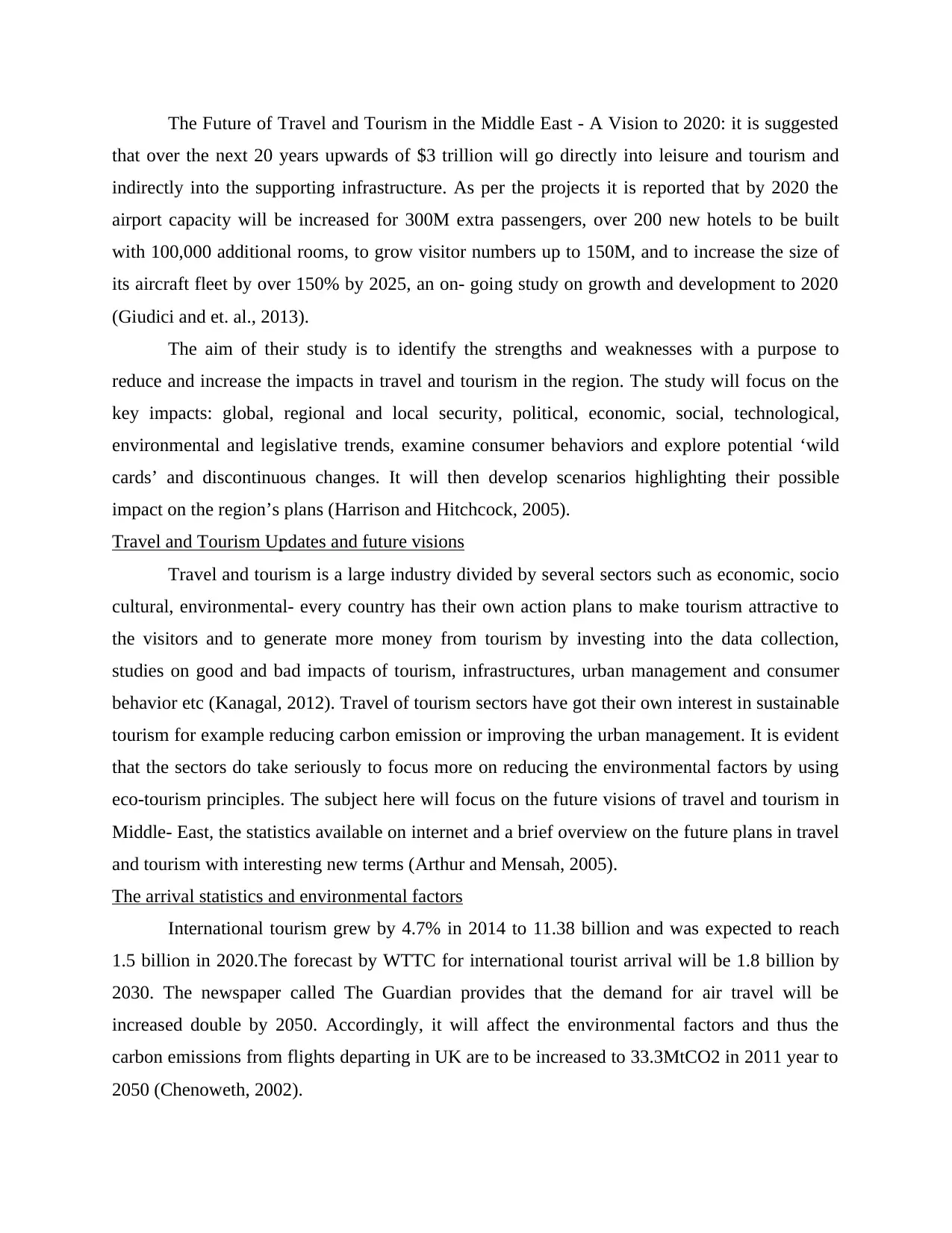
The Future of Travel and Tourism in the Middle East - A Vision to 2020: it is suggested
that over the next 20 years upwards of $3 trillion will go directly into leisure and tourism and
indirectly into the supporting infrastructure. As per the projects it is reported that by 2020 the
airport capacity will be increased for 300M extra passengers, over 200 new hotels to be built
with 100,000 additional rooms, to grow visitor numbers up to 150M, and to increase the size of
its aircraft fleet by over 150% by 2025, an on- going study on growth and development to 2020
(Giudici and et. al., 2013).
The aim of their study is to identify the strengths and weaknesses with a purpose to
reduce and increase the impacts in travel and tourism in the region. The study will focus on the
key impacts: global, regional and local security, political, economic, social, technological,
environmental and legislative trends, examine consumer behaviors and explore potential ‘wild
cards’ and discontinuous changes. It will then develop scenarios highlighting their possible
impact on the region’s plans (Harrison and Hitchcock, 2005).
Travel and Tourism Updates and future visions
Travel and tourism is a large industry divided by several sectors such as economic, socio
cultural, environmental- every country has their own action plans to make tourism attractive to
the visitors and to generate more money from tourism by investing into the data collection,
studies on good and bad impacts of tourism, infrastructures, urban management and consumer
behavior etc (Kanagal, 2012). Travel of tourism sectors have got their own interest in sustainable
tourism for example reducing carbon emission or improving the urban management. It is evident
that the sectors do take seriously to focus more on reducing the environmental factors by using
eco-tourism principles. The subject here will focus on the future visions of travel and tourism in
Middle- East, the statistics available on internet and a brief overview on the future plans in travel
and tourism with interesting new terms (Arthur and Mensah, 2005).
The arrival statistics and environmental factors
International tourism grew by 4.7% in 2014 to 11.38 billion and was expected to reach
1.5 billion in 2020.The forecast by WTTC for international tourist arrival will be 1.8 billion by
2030. The newspaper called The Guardian provides that the demand for air travel will be
increased double by 2050. Accordingly, it will affect the environmental factors and thus the
carbon emissions from flights departing in UK are to be increased to 33.3MtCO2 in 2011 year to
2050 (Chenoweth, 2002).
that over the next 20 years upwards of $3 trillion will go directly into leisure and tourism and
indirectly into the supporting infrastructure. As per the projects it is reported that by 2020 the
airport capacity will be increased for 300M extra passengers, over 200 new hotels to be built
with 100,000 additional rooms, to grow visitor numbers up to 150M, and to increase the size of
its aircraft fleet by over 150% by 2025, an on- going study on growth and development to 2020
(Giudici and et. al., 2013).
The aim of their study is to identify the strengths and weaknesses with a purpose to
reduce and increase the impacts in travel and tourism in the region. The study will focus on the
key impacts: global, regional and local security, political, economic, social, technological,
environmental and legislative trends, examine consumer behaviors and explore potential ‘wild
cards’ and discontinuous changes. It will then develop scenarios highlighting their possible
impact on the region’s plans (Harrison and Hitchcock, 2005).
Travel and Tourism Updates and future visions
Travel and tourism is a large industry divided by several sectors such as economic, socio
cultural, environmental- every country has their own action plans to make tourism attractive to
the visitors and to generate more money from tourism by investing into the data collection,
studies on good and bad impacts of tourism, infrastructures, urban management and consumer
behavior etc (Kanagal, 2012). Travel of tourism sectors have got their own interest in sustainable
tourism for example reducing carbon emission or improving the urban management. It is evident
that the sectors do take seriously to focus more on reducing the environmental factors by using
eco-tourism principles. The subject here will focus on the future visions of travel and tourism in
Middle- East, the statistics available on internet and a brief overview on the future plans in travel
and tourism with interesting new terms (Arthur and Mensah, 2005).
The arrival statistics and environmental factors
International tourism grew by 4.7% in 2014 to 11.38 billion and was expected to reach
1.5 billion in 2020.The forecast by WTTC for international tourist arrival will be 1.8 billion by
2030. The newspaper called The Guardian provides that the demand for air travel will be
increased double by 2050. Accordingly, it will affect the environmental factors and thus the
carbon emissions from flights departing in UK are to be increased to 33.3MtCO2 in 2011 year to
2050 (Chenoweth, 2002).
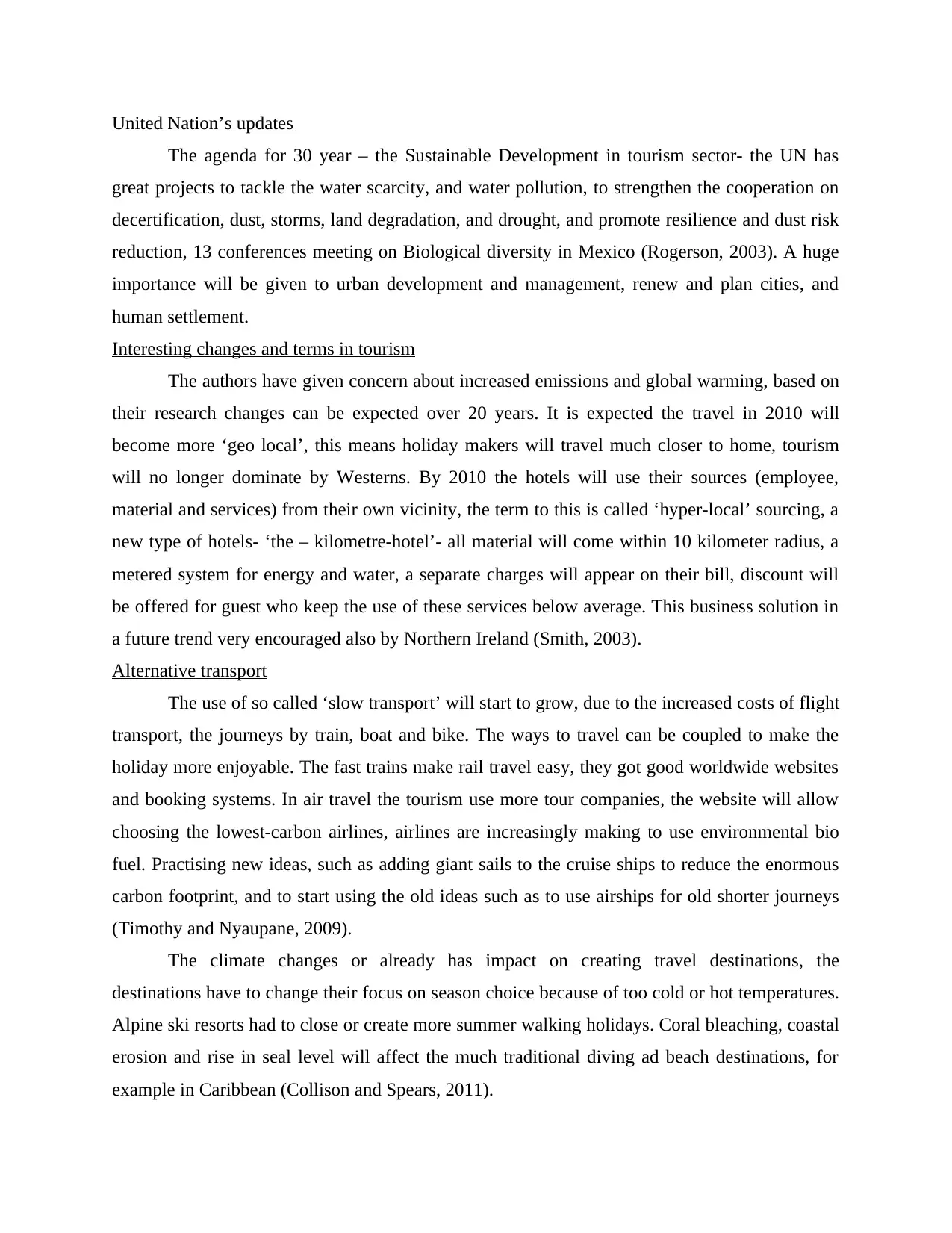
United Nation’s updates
The agenda for 30 year – the Sustainable Development in tourism sector- the UN has
great projects to tackle the water scarcity, and water pollution, to strengthen the cooperation on
decertification, dust, storms, land degradation, and drought, and promote resilience and dust risk
reduction, 13 conferences meeting on Biological diversity in Mexico (Rogerson, 2003). A huge
importance will be given to urban development and management, renew and plan cities, and
human settlement.
Interesting changes and terms in tourism
The authors have given concern about increased emissions and global warming, based on
their research changes can be expected over 20 years. It is expected the travel in 2010 will
become more ‘geo local’, this means holiday makers will travel much closer to home, tourism
will no longer dominate by Westerns. By 2010 the hotels will use their sources (employee,
material and services) from their own vicinity, the term to this is called ‘hyper-local’ sourcing, a
new type of hotels- ‘the – kilometre-hotel’- all material will come within 10 kilometer radius, a
metered system for energy and water, a separate charges will appear on their bill, discount will
be offered for guest who keep the use of these services below average. This business solution in
a future trend very encouraged also by Northern Ireland (Smith, 2003).
Alternative transport
The use of so called ‘slow transport’ will start to grow, due to the increased costs of flight
transport, the journeys by train, boat and bike. The ways to travel can be coupled to make the
holiday more enjoyable. The fast trains make rail travel easy, they got good worldwide websites
and booking systems. In air travel the tourism use more tour companies, the website will allow
choosing the lowest-carbon airlines, airlines are increasingly making to use environmental bio
fuel. Practising new ideas, such as adding giant sails to the cruise ships to reduce the enormous
carbon footprint, and to start using the old ideas such as to use airships for old shorter journeys
(Timothy and Nyaupane, 2009).
The climate changes or already has impact on creating travel destinations, the
destinations have to change their focus on season choice because of too cold or hot temperatures.
Alpine ski resorts had to close or create more summer walking holidays. Coral bleaching, coastal
erosion and rise in seal level will affect the much traditional diving ad beach destinations, for
example in Caribbean (Collison and Spears, 2011).
The agenda for 30 year – the Sustainable Development in tourism sector- the UN has
great projects to tackle the water scarcity, and water pollution, to strengthen the cooperation on
decertification, dust, storms, land degradation, and drought, and promote resilience and dust risk
reduction, 13 conferences meeting on Biological diversity in Mexico (Rogerson, 2003). A huge
importance will be given to urban development and management, renew and plan cities, and
human settlement.
Interesting changes and terms in tourism
The authors have given concern about increased emissions and global warming, based on
their research changes can be expected over 20 years. It is expected the travel in 2010 will
become more ‘geo local’, this means holiday makers will travel much closer to home, tourism
will no longer dominate by Westerns. By 2010 the hotels will use their sources (employee,
material and services) from their own vicinity, the term to this is called ‘hyper-local’ sourcing, a
new type of hotels- ‘the – kilometre-hotel’- all material will come within 10 kilometer radius, a
metered system for energy and water, a separate charges will appear on their bill, discount will
be offered for guest who keep the use of these services below average. This business solution in
a future trend very encouraged also by Northern Ireland (Smith, 2003).
Alternative transport
The use of so called ‘slow transport’ will start to grow, due to the increased costs of flight
transport, the journeys by train, boat and bike. The ways to travel can be coupled to make the
holiday more enjoyable. The fast trains make rail travel easy, they got good worldwide websites
and booking systems. In air travel the tourism use more tour companies, the website will allow
choosing the lowest-carbon airlines, airlines are increasingly making to use environmental bio
fuel. Practising new ideas, such as adding giant sails to the cruise ships to reduce the enormous
carbon footprint, and to start using the old ideas such as to use airships for old shorter journeys
(Timothy and Nyaupane, 2009).
The climate changes or already has impact on creating travel destinations, the
destinations have to change their focus on season choice because of too cold or hot temperatures.
Alpine ski resorts had to close or create more summer walking holidays. Coral bleaching, coastal
erosion and rise in seal level will affect the much traditional diving ad beach destinations, for
example in Caribbean (Collison and Spears, 2011).
Secure Best Marks with AI Grader
Need help grading? Try our AI Grader for instant feedback on your assignments.
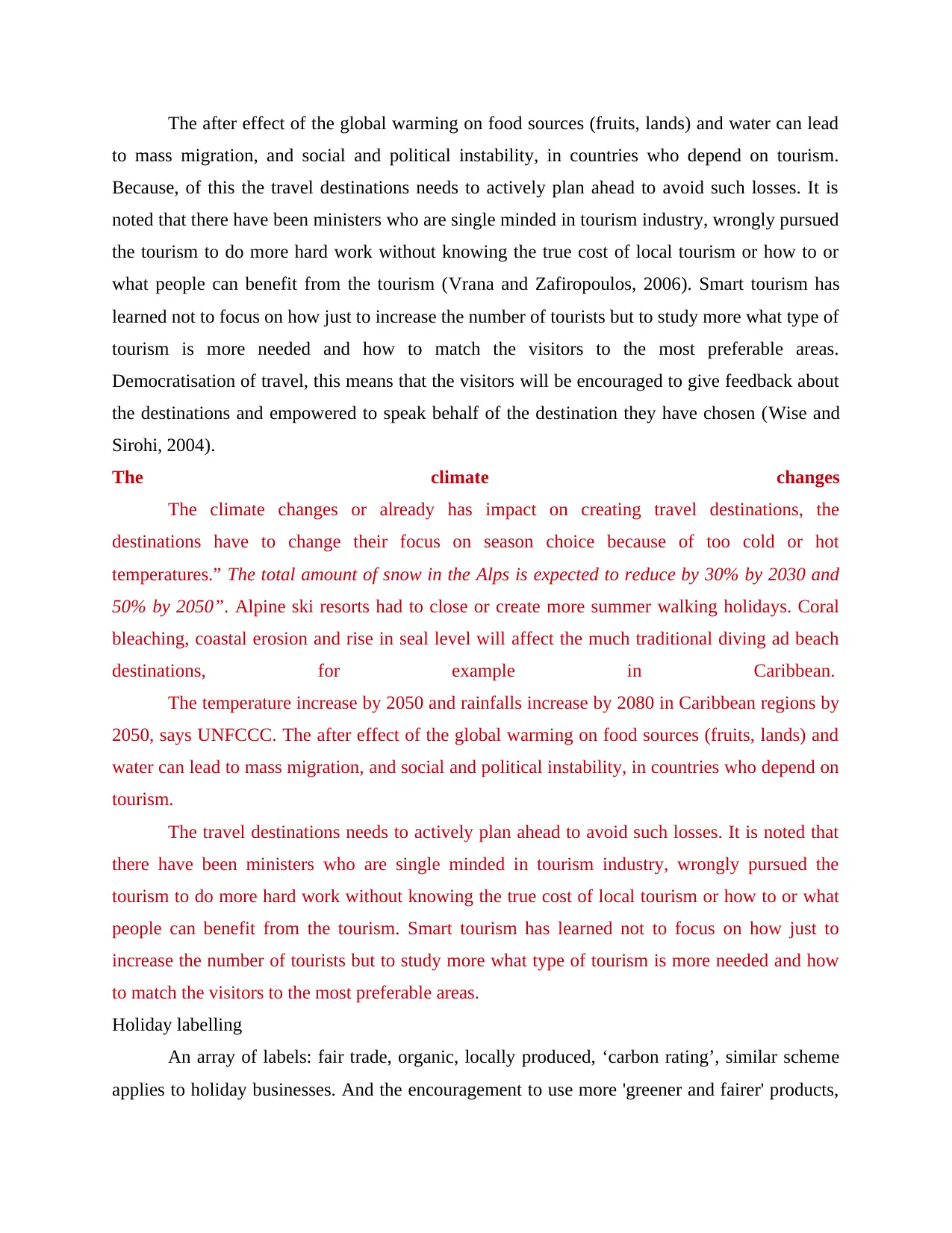
The after effect of the global warming on food sources (fruits, lands) and water can lead
to mass migration, and social and political instability, in countries who depend on tourism.
Because, of this the travel destinations needs to actively plan ahead to avoid such losses. It is
noted that there have been ministers who are single minded in tourism industry, wrongly pursued
the tourism to do more hard work without knowing the true cost of local tourism or how to or
what people can benefit from the tourism (Vrana and Zafiropoulos, 2006). Smart tourism has
learned not to focus on how just to increase the number of tourists but to study more what type of
tourism is more needed and how to match the visitors to the most preferable areas.
Democratisation of travel, this means that the visitors will be encouraged to give feedback about
the destinations and empowered to speak behalf of the destination they have chosen (Wise and
Sirohi, 2004).
The climate changes
The climate changes or already has impact on creating travel destinations, the
destinations have to change their focus on season choice because of too cold or hot
temperatures.” The total amount of snow in the Alps is expected to reduce by 30% by 2030 and
50% by 2050”. Alpine ski resorts had to close or create more summer walking holidays. Coral
bleaching, coastal erosion and rise in seal level will affect the much traditional diving ad beach
destinations, for example in Caribbean.
The temperature increase by 2050 and rainfalls increase by 2080 in Caribbean regions by
2050, says UNFCCC. The after effect of the global warming on food sources (fruits, lands) and
water can lead to mass migration, and social and political instability, in countries who depend on
tourism.
The travel destinations needs to actively plan ahead to avoid such losses. It is noted that
there have been ministers who are single minded in tourism industry, wrongly pursued the
tourism to do more hard work without knowing the true cost of local tourism or how to or what
people can benefit from the tourism. Smart tourism has learned not to focus on how just to
increase the number of tourists but to study more what type of tourism is more needed and how
to match the visitors to the most preferable areas.
Holiday labelling
An array of labels: fair trade, organic, locally produced, ‘carbon rating’, similar scheme
applies to holiday businesses. And the encouragement to use more 'greener and fairer' products,
to mass migration, and social and political instability, in countries who depend on tourism.
Because, of this the travel destinations needs to actively plan ahead to avoid such losses. It is
noted that there have been ministers who are single minded in tourism industry, wrongly pursued
the tourism to do more hard work without knowing the true cost of local tourism or how to or
what people can benefit from the tourism (Vrana and Zafiropoulos, 2006). Smart tourism has
learned not to focus on how just to increase the number of tourists but to study more what type of
tourism is more needed and how to match the visitors to the most preferable areas.
Democratisation of travel, this means that the visitors will be encouraged to give feedback about
the destinations and empowered to speak behalf of the destination they have chosen (Wise and
Sirohi, 2004).
The climate changes
The climate changes or already has impact on creating travel destinations, the
destinations have to change their focus on season choice because of too cold or hot
temperatures.” The total amount of snow in the Alps is expected to reduce by 30% by 2030 and
50% by 2050”. Alpine ski resorts had to close or create more summer walking holidays. Coral
bleaching, coastal erosion and rise in seal level will affect the much traditional diving ad beach
destinations, for example in Caribbean.
The temperature increase by 2050 and rainfalls increase by 2080 in Caribbean regions by
2050, says UNFCCC. The after effect of the global warming on food sources (fruits, lands) and
water can lead to mass migration, and social and political instability, in countries who depend on
tourism.
The travel destinations needs to actively plan ahead to avoid such losses. It is noted that
there have been ministers who are single minded in tourism industry, wrongly pursued the
tourism to do more hard work without knowing the true cost of local tourism or how to or what
people can benefit from the tourism. Smart tourism has learned not to focus on how just to
increase the number of tourists but to study more what type of tourism is more needed and how
to match the visitors to the most preferable areas.
Holiday labelling
An array of labels: fair trade, organic, locally produced, ‘carbon rating’, similar scheme
applies to holiday businesses. And the encouragement to use more 'greener and fairer' products,
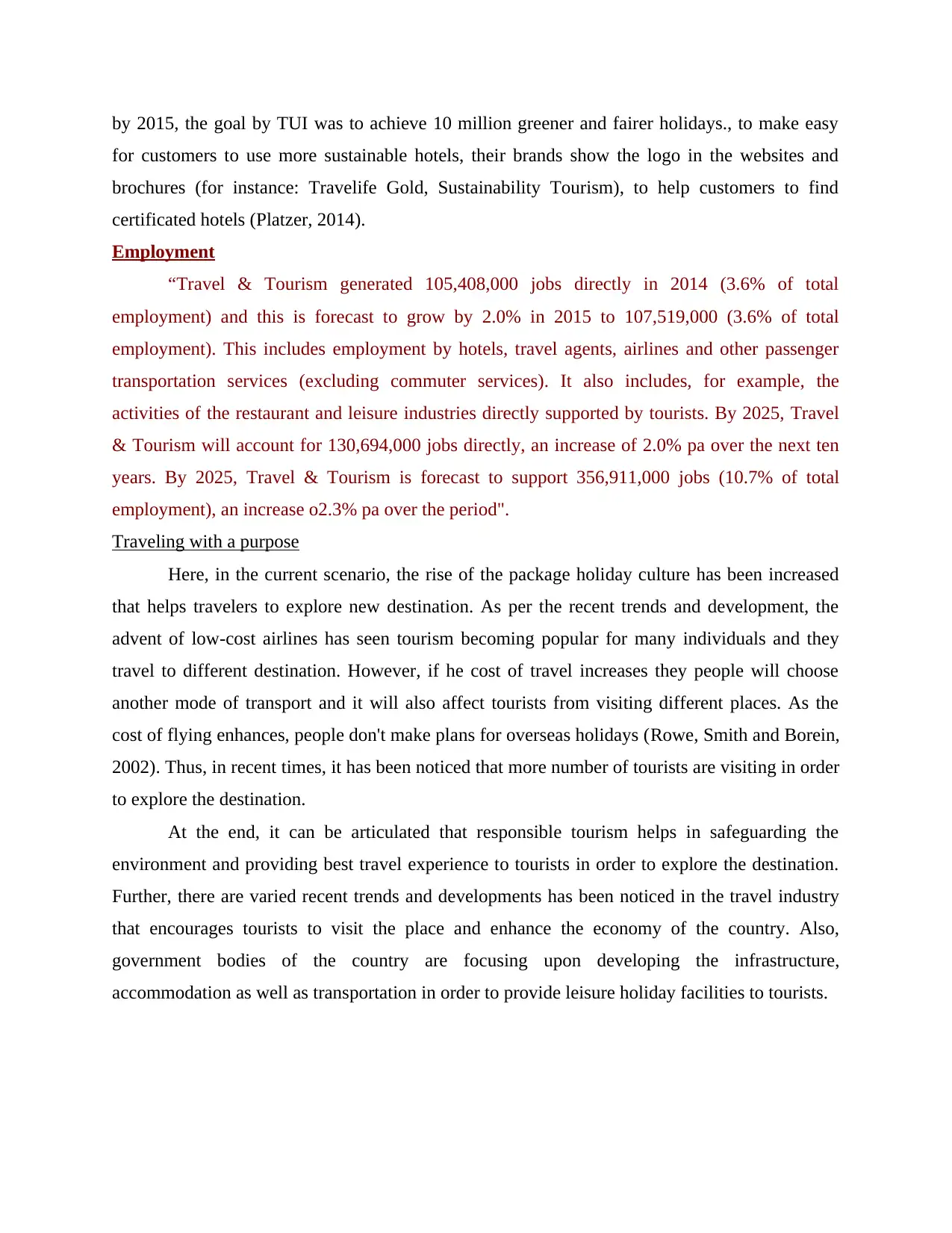
by 2015, the goal by TUI was to achieve 10 million greener and fairer holidays., to make easy
for customers to use more sustainable hotels, their brands show the logo in the websites and
brochures (for instance: Travelife Gold, Sustainability Tourism), to help customers to find
certificated hotels (Platzer, 2014).
Employment
“Travel & Tourism generated 105,408,000 jobs directly in 2014 (3.6% of total
employment) and this is forecast to grow by 2.0% in 2015 to 107,519,000 (3.6% of total
employment). This includes employment by hotels, travel agents, airlines and other passenger
transportation services (excluding commuter services). It also includes, for example, the
activities of the restaurant and leisure industries directly supported by tourists. By 2025, Travel
& Tourism will account for 130,694,000 jobs directly, an increase of 2.0% pa over the next ten
years. By 2025, Travel & Tourism is forecast to support 356,911,000 jobs (10.7% of total
employment), an increase o2.3% pa over the period".
Traveling with a purpose
Here, in the current scenario, the rise of the package holiday culture has been increased
that helps travelers to explore new destination. As per the recent trends and development, the
advent of low-cost airlines has seen tourism becoming popular for many individuals and they
travel to different destination. However, if he cost of travel increases they people will choose
another mode of transport and it will also affect tourists from visiting different places. As the
cost of flying enhances, people don't make plans for overseas holidays (Rowe, Smith and Borein,
2002). Thus, in recent times, it has been noticed that more number of tourists are visiting in order
to explore the destination.
At the end, it can be articulated that responsible tourism helps in safeguarding the
environment and providing best travel experience to tourists in order to explore the destination.
Further, there are varied recent trends and developments has been noticed in the travel industry
that encourages tourists to visit the place and enhance the economy of the country. Also,
government bodies of the country are focusing upon developing the infrastructure,
accommodation as well as transportation in order to provide leisure holiday facilities to tourists.
for customers to use more sustainable hotels, their brands show the logo in the websites and
brochures (for instance: Travelife Gold, Sustainability Tourism), to help customers to find
certificated hotels (Platzer, 2014).
Employment
“Travel & Tourism generated 105,408,000 jobs directly in 2014 (3.6% of total
employment) and this is forecast to grow by 2.0% in 2015 to 107,519,000 (3.6% of total
employment). This includes employment by hotels, travel agents, airlines and other passenger
transportation services (excluding commuter services). It also includes, for example, the
activities of the restaurant and leisure industries directly supported by tourists. By 2025, Travel
& Tourism will account for 130,694,000 jobs directly, an increase of 2.0% pa over the next ten
years. By 2025, Travel & Tourism is forecast to support 356,911,000 jobs (10.7% of total
employment), an increase o2.3% pa over the period".
Traveling with a purpose
Here, in the current scenario, the rise of the package holiday culture has been increased
that helps travelers to explore new destination. As per the recent trends and development, the
advent of low-cost airlines has seen tourism becoming popular for many individuals and they
travel to different destination. However, if he cost of travel increases they people will choose
another mode of transport and it will also affect tourists from visiting different places. As the
cost of flying enhances, people don't make plans for overseas holidays (Rowe, Smith and Borein,
2002). Thus, in recent times, it has been noticed that more number of tourists are visiting in order
to explore the destination.
At the end, it can be articulated that responsible tourism helps in safeguarding the
environment and providing best travel experience to tourists in order to explore the destination.
Further, there are varied recent trends and developments has been noticed in the travel industry
that encourages tourists to visit the place and enhance the economy of the country. Also,
government bodies of the country are focusing upon developing the infrastructure,
accommodation as well as transportation in order to provide leisure holiday facilities to tourists.
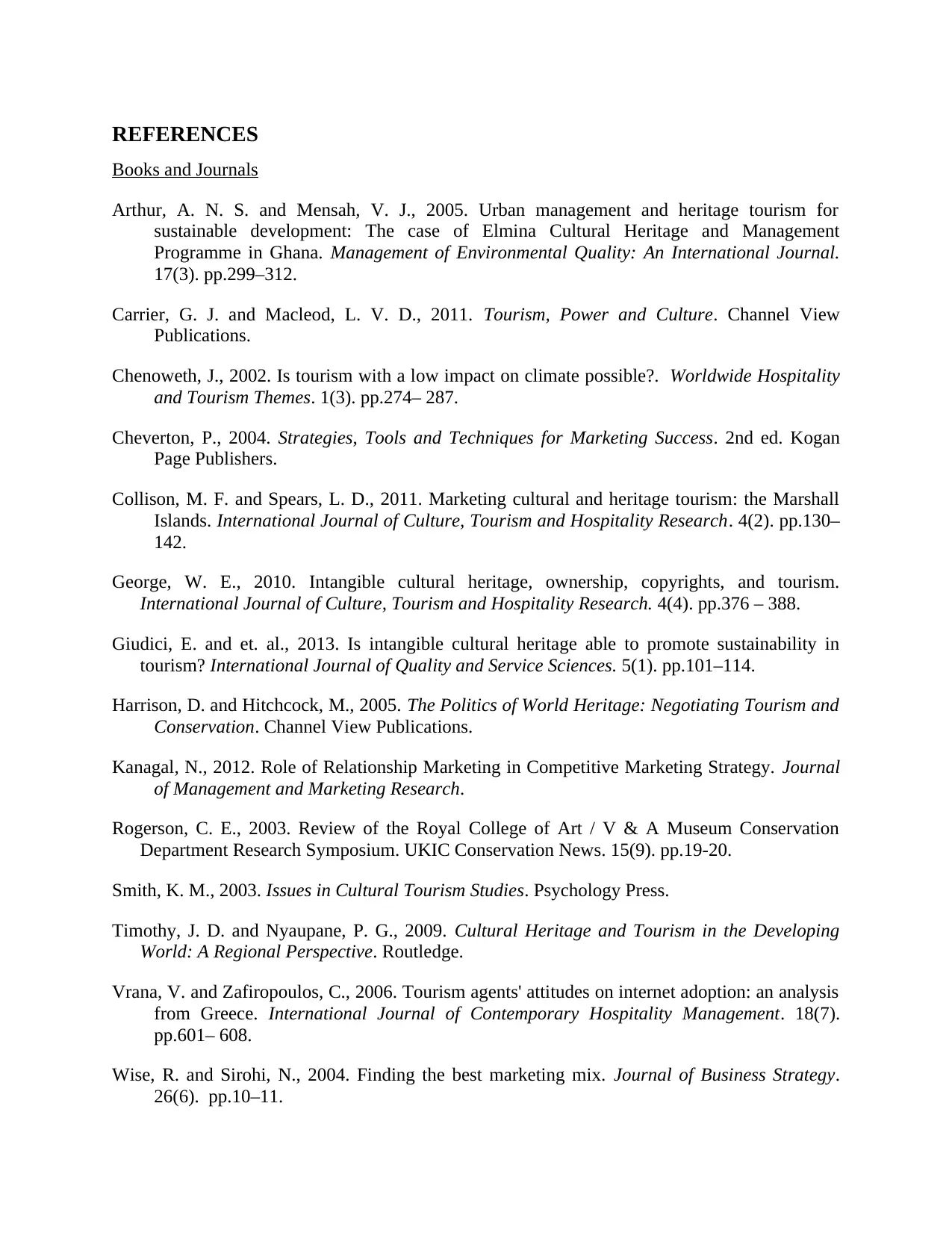
REFERENCES
Books and Journals
Arthur, A. N. S. and Mensah, V. J., 2005. Urban management and heritage tourism for
sustainable development: The case of Elmina Cultural Heritage and Management
Programme in Ghana. Management of Environmental Quality: An International Journal.
17(3). pp.299–312.
Carrier, G. J. and Macleod, L. V. D., 2011. Tourism, Power and Culture. Channel View
Publications.
Chenoweth, J., 2002. Is tourism with a low impact on climate possible?. Worldwide Hospitality
and Tourism Themes. 1(3). pp.274– 287.
Cheverton, P., 2004. Strategies, Tools and Techniques for Marketing Success. 2nd ed. Kogan
Page Publishers.
Collison, M. F. and Spears, L. D., 2011. Marketing cultural and heritage tourism: the Marshall
Islands. International Journal of Culture, Tourism and Hospitality Research. 4(2). pp.130–
142.
George, W. E., 2010. Intangible cultural heritage, ownership, copyrights, and tourism.
International Journal of Culture, Tourism and Hospitality Research. 4(4). pp.376 – 388.
Giudici, E. and et. al., 2013. Is intangible cultural heritage able to promote sustainability in
tourism? International Journal of Quality and Service Sciences. 5(1). pp.101–114.
Harrison, D. and Hitchcock, M., 2005. The Politics of World Heritage: Negotiating Tourism and
Conservation. Channel View Publications.
Kanagal, N., 2012. Role of Relationship Marketing in Competitive Marketing Strategy. Journal
of Management and Marketing Research.
Rogerson, C. E., 2003. Review of the Royal College of Art / V & A Museum Conservation
Department Research Symposium. UKIC Conservation News. 15(9). pp.19-20.
Smith, K. M., 2003. Issues in Cultural Tourism Studies. Psychology Press.
Timothy, J. D. and Nyaupane, P. G., 2009. Cultural Heritage and Tourism in the Developing
World: A Regional Perspective. Routledge.
Vrana, V. and Zafiropoulos, C., 2006. Tourism agents' attitudes on internet adoption: an analysis
from Greece. International Journal of Contemporary Hospitality Management. 18(7).
pp.601– 608.
Wise, R. and Sirohi, N., 2004. Finding the best marketing mix. Journal of Business Strategy.
26(6). pp.10–11.
Books and Journals
Arthur, A. N. S. and Mensah, V. J., 2005. Urban management and heritage tourism for
sustainable development: The case of Elmina Cultural Heritage and Management
Programme in Ghana. Management of Environmental Quality: An International Journal.
17(3). pp.299–312.
Carrier, G. J. and Macleod, L. V. D., 2011. Tourism, Power and Culture. Channel View
Publications.
Chenoweth, J., 2002. Is tourism with a low impact on climate possible?. Worldwide Hospitality
and Tourism Themes. 1(3). pp.274– 287.
Cheverton, P., 2004. Strategies, Tools and Techniques for Marketing Success. 2nd ed. Kogan
Page Publishers.
Collison, M. F. and Spears, L. D., 2011. Marketing cultural and heritage tourism: the Marshall
Islands. International Journal of Culture, Tourism and Hospitality Research. 4(2). pp.130–
142.
George, W. E., 2010. Intangible cultural heritage, ownership, copyrights, and tourism.
International Journal of Culture, Tourism and Hospitality Research. 4(4). pp.376 – 388.
Giudici, E. and et. al., 2013. Is intangible cultural heritage able to promote sustainability in
tourism? International Journal of Quality and Service Sciences. 5(1). pp.101–114.
Harrison, D. and Hitchcock, M., 2005. The Politics of World Heritage: Negotiating Tourism and
Conservation. Channel View Publications.
Kanagal, N., 2012. Role of Relationship Marketing in Competitive Marketing Strategy. Journal
of Management and Marketing Research.
Rogerson, C. E., 2003. Review of the Royal College of Art / V & A Museum Conservation
Department Research Symposium. UKIC Conservation News. 15(9). pp.19-20.
Smith, K. M., 2003. Issues in Cultural Tourism Studies. Psychology Press.
Timothy, J. D. and Nyaupane, P. G., 2009. Cultural Heritage and Tourism in the Developing
World: A Regional Perspective. Routledge.
Vrana, V. and Zafiropoulos, C., 2006. Tourism agents' attitudes on internet adoption: an analysis
from Greece. International Journal of Contemporary Hospitality Management. 18(7).
pp.601– 608.
Wise, R. and Sirohi, N., 2004. Finding the best marketing mix. Journal of Business Strategy.
26(6). pp.10–11.
Paraphrase This Document
Need a fresh take? Get an instant paraphrase of this document with our AI Paraphraser
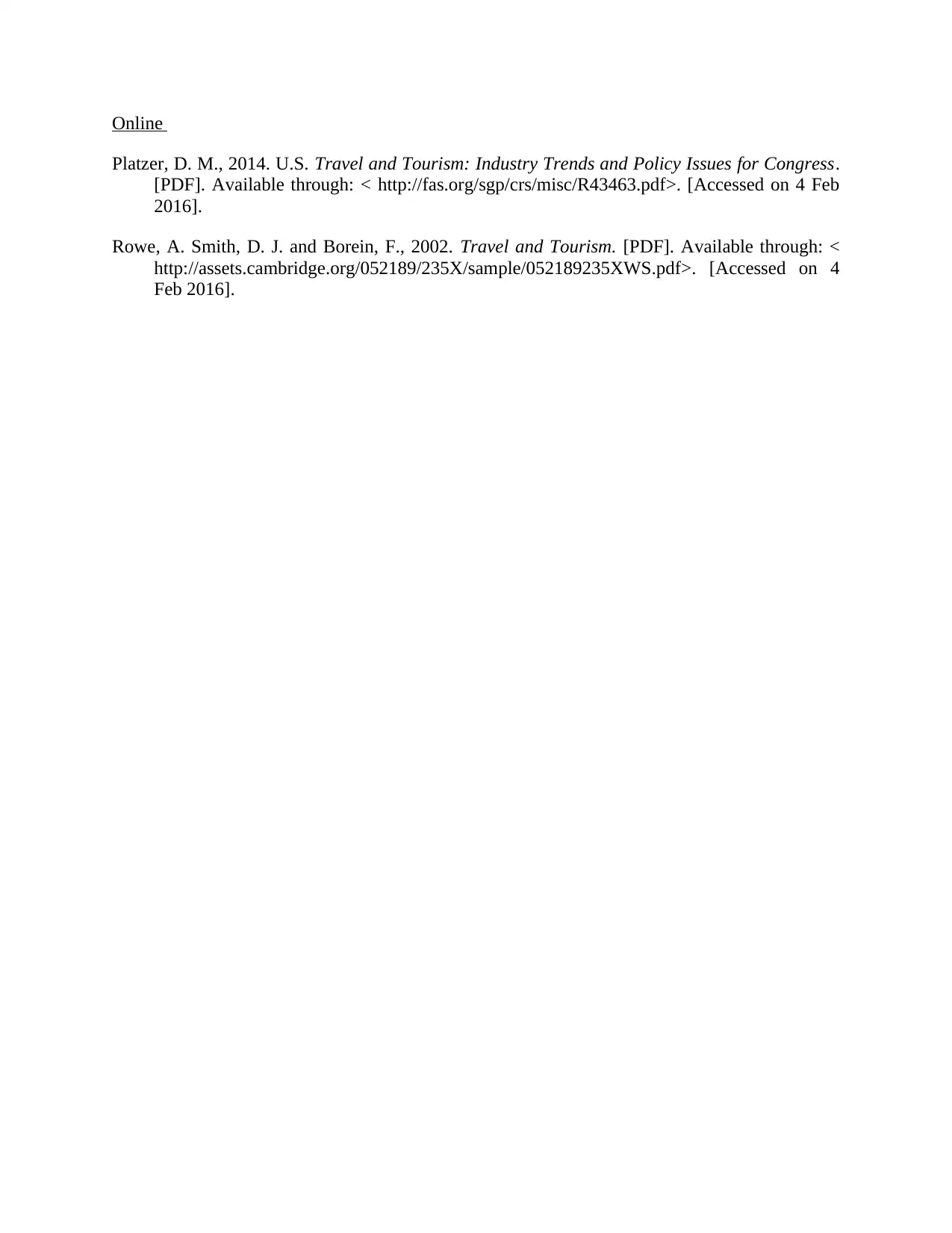
Online
Platzer, D. M., 2014. U.S. Travel and Tourism: Industry Trends and Policy Issues for Congress.
[PDF]. Available through: < http://fas.org/sgp/crs/misc/R43463.pdf>. [Accessed on 4 Feb
2016].
Rowe, A. Smith, D. J. and Borein, F., 2002. Travel and Tourism. [PDF]. Available through: <
http://assets.cambridge.org/052189/235X/sample/052189235XWS.pdf>. [Accessed on 4
Feb 2016].
Platzer, D. M., 2014. U.S. Travel and Tourism: Industry Trends and Policy Issues for Congress.
[PDF]. Available through: < http://fas.org/sgp/crs/misc/R43463.pdf>. [Accessed on 4 Feb
2016].
Rowe, A. Smith, D. J. and Borein, F., 2002. Travel and Tourism. [PDF]. Available through: <
http://assets.cambridge.org/052189/235X/sample/052189235XWS.pdf>. [Accessed on 4
Feb 2016].
1 out of 8
Related Documents
Your All-in-One AI-Powered Toolkit for Academic Success.
+13062052269
info@desklib.com
Available 24*7 on WhatsApp / Email
![[object Object]](/_next/static/media/star-bottom.7253800d.svg)
Unlock your academic potential
© 2024 | Zucol Services PVT LTD | All rights reserved.




